
Flag Etiquette
Guidelines for Teaching Flag Etiquette in Missouri Public Schools

Introduction
This booklet was developed as a result of legislation (House Bill 630) enacted by the Missouri General Assembly in 1997. The bill was sponsored by Rep. Bill Boucher of Kansas City and Rep. Bill Ransdall of Waynesville. The law is now found in state statutes as Section 161.104, RSMo.
The intent of this law and the State Board of Education's accompanying regulation is to encourage local schools to provide appropriate instruction for young people about the United States flag and flag etiquette. Local schools have discretion, however, in deciding how and when such instruction will be provided.
The Department of Elementary and Secondary Education acknowledges the encouragement and assistance of Representatives Boucher and Ransdall in developing this material. The Department also is grateful to the following statewide organizations for their assistance and support in developing this booklet for local schools:
- The American Legion
- Disabled American Veterans
- Veterans of Foreign Wars
- The Missouri Association of Veterans' Organizations
Except for the cover, the illustrations used in this publication were originally created by The American Legion and are used here with permission.
Statutory Authority
Here is the complete text of the 1997 state law concerning instruction about flag etiquette.
Section 161.104 - State board to adopt rules on instruction of etiquette concerning the U.S. flag.
- The state board of education shall provide by rule for a program of instruction relating to the flag of the United States of America and instruction in etiquette and in its correct use and display and such other patriotic exercises as may be expedient. Such instruction, at a minimum, shall include sections 36 U.S.C. 170 to 177.*
- No rule or portion of a rule promulgated pursuant to the authority of this section shall become effective unless it has been promulgated pursuant to the provisions of section 536.024, RSMo.
*Note: Throughout this material, reference is made to "The Flag Code" and to different sections of Title 36 of the United States Code (U.S.C.) or the United States Code Annotated (U.S.C.A.). The Flag Code was adopted into federal law by Congress on July 7, 1976 (Public Law 344). In this publication, all references to The Flag Code are based on this source.
The Missouri State Board of Education adopted a regulation, as required by this statute, in June of 1998. The rule became effective October 30, 1998. It may be found in the Code of State Regulations (CSR) under 5 CSR 50-865.400 and in Appendix B of this publication.
Ideas For Instruction In Flag Etiquette
Activities
- At the first assembly of the school year, have the principal, a faculty member, a student, or a person from the community show students how to stand during the playing of the national anthem. At future assemblies, have someone on stage model the proper way to stand, with teachers and Student Council members reinforcing what that person does.
- In elementary classes, discuss the meaning of the words in the Pledge of Allegiance. Discuss what this or any other country would be like if it did not have liberty and justice and if its people were so divided that they could not live peacefully with each other. Students could show what they learned by dramatizations or by making drawings to illustrate their ideas.
- Have older students create posters, using newspaper articles they find, that show examples of liberty, justice, and people living peacefully together as opposed to other examples showing those conditions not being present in different parts of the world. Maps could show the locations of the sites where the stories took place.
- Have a group of students, perhaps Student Council members or Scouts, together with a student who plays a trumpet, lead a dignified flag-raising ceremony and a flag-lowering ceremony each day at the flagpole by the front of the school. If such a ceremony is not conducted each day, it could be conducted in connection with national and state holidays, special school or community events, or on the first day of the week. Prior to such ceremonies, students need to be instructed on how to behave during the ceremony. (See Sections 174d and 177 of The Flag Code, Appendix A.)
- Have students study and then demonstrate proper displays of the flag using flags and The Flag Code as resources. (See Section 175 of The Flag Code, Appendix A.)
- As a follow-up to Activity 5, have students discuss the rationale for the code, i.e., why flags are sometimes flown at half staff, or why flags of two or more nations are flown from separate staffs of the same height and are approximately the same size.
- Have students conduct research on the flag as a symbol that evokes strong feelings among many of our citizens, such as those who have fought for this country and those who have immigrated from other nations.
- Have students discuss the ideals the flag represents, such as liberty and justice, and even the right of some citizens not to pledge allegiance to it. There was a controversy over students in school saluting the flag, which resulted in two Supreme Court decisions in the 1940s. Those cases are Minersville v. Gobitis (1940) and West Virginia State Board of Education v. Barnette (1943). Students could conduct research about these cases and present reports to the class in a variety of creative ways.
- Have students collect or make pictures of the various forms the U.S. flag has taken since our nation's beginnings. Have them investigate and explain the symbolism in the various forms of the flag, how and why it has changed, and how it has stayed the same.
- Have students investigate and identify arguments concerning a constitutional amendment that would outlaw desecration of the United States flag.
Resources
To assist in conducting research about the flag, its history, and etiquette concerning its use, schools should consider the following sources:
- School and Public Libraries
- Organizations
There are many organizations who may be contacted by teachers and/or students for assistance with flag-related activities and patriotic observances. Many of these organizations have offices or local affiliates throughout the state. Only a few of them are listed here.- The American Legion, State of Missouri, P.O. Box 179, Jefferson City, MO 65102-0179
(Phone: 573-893-2353, Fax: 573-893-2980) - Veterans of Foreign Wars of the United States, VFW Building, 406 West 34th Street, Kansas City, MO 64111 (Phone: 816-756-3390, Fax: 8169681157). The VFW has a curriculum entitled Citizenship Education Programs for School and Youth Groups - Curriculum Guide for Educators, which it provides to schools at no cost.
- The American Legion, State of Missouri, P.O. Box 179, Jefferson City, MO 65102-0179
- Resources on the Web
There is a wealth of flag-related information and resources available to students and teachers. Here are just a few currently available sites:
Appendix A
Excerpts from The Flag Code
The following excerpts from The Flag Code may be used in connection with Activities 4 and 5.
§ 174. Time and occasions for display; hoisting and lowering(d) The flag should be displayed on all days, especially on:
- New Year's Day - January 1
- Inauguration Day - January 20
- Lincoln's Birthday - February 12
- Washington's Birthday - third Monday in February
- Easter Sunday - (variable)
- Mother's Day - second Sunday in May
- Armed Forces Day - third Saturday in May
- Memorial Day (half-staff until noon) - last Monday in May
- Flag Day - June 14
- Independence Day - July 4
- Labor Day - first Monday in September
- Constitution Day - September 17
- Columbus Day - second Monday in October
- Navy Day - October 27
- Veterans Day - November 11
- Thanksgiving Day - fourth Thursday in November
- Christmas Day - December 25
- Other days as may be proclaimed by the President of the United States
- Birthdays of States (date of admission)
- State holidays
|
§ 175. Position and manner of display The flag, when carried in a procession with another flag or flags, should be either on the marching right; that is, the flag's own right, or, if there is a line of other flags, in front of the center of that line. (a) The flag should not be displayed on a float in a parade except from a staff, or as provided in subsection (i) of this section. (b) The flag should not be draped over the hood, top, sides, or back of a vehicle or of a railroad train or a boat. When the flag is displayed on a motorcar, the staff shall be fixed firmly to the chassis or clamped to the right fender. (c) No other flag or pennant should be placed above, or, if on the same level, to the right of the flag of the United States of America, except during church services conducted by naval chaplains at sea, when the church pennant may be flown above the flag during church services for the personnel of the Navy. No person shall display the flag of the United Nations or any other national or international flag equal, above, or in a position of superior prominence or honor to, or in place of, the flag of the United States at any place within the United States or any Territory or possession thereof: Provided, That nothing in this section shall make unlawful the continuance of the practice heretofore followed of displaying the flag of the United Nations in a position of superior prominence or honor, and other national flags in positions of equal prominence or honor, with that of the flag of the United States at the headquarters of the United Nations. |
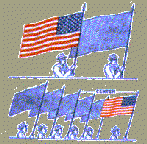
|
|
(d) The flag of the United States of America, when it is displayed with another flag against a wall from crossed staffs, should be on the right, the flag's own right, and its staff should be in front of the staff of the other flag. |

|
| (e) The flag of the United States of America should be at the center and at the highest point of the group when a number of flags of States or localities or pennants of societies are grouped and displayed from staffs. |
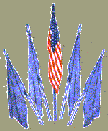
|
| (f) When flags of States, cities, or localities, or pennants of societies are flown on the same halyard with the flag of the United States, the latter should always be at the peak. When the flags are flown from adjacent staffs, the flag of the United States should be hoisted first and lowered last. No such flag or pennant may be placed above the flag of the United States or to the United States flag's right. |

|
| (g) When flags of two or more nations are displayed, they are to be flown from separate staffs of the same height. The flags should be of approximately equal size. International usage forbids the display of the flag of one nation above that of another nation in time of peace. |

|
| (h) When the flag of the United States is displayed from a staff projecting horizontally or at an angle from the window sill, balcony, or front of a building, the union of the flag should be placed at the peak of the staff unless the flag is at half staff. When the flag is suspended over a sidewalk from a rope extending from a house to a pole at the edge of the sidewalk, the flag should be hoisted out, union first, from the building. |
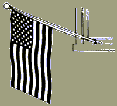
|
| (i) When displayed either horizontally or vertically against a wall, the union should be uppermost and to the flag's own right, that is, to the observer's left. When displayed in a window, the flag should be displayed in the same way, with the union or blue field to the left of the observer in the street. |
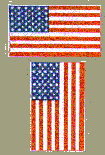
|
|
(j) When the flag is displayed over the middle of the street, it should be suspended vertically with the union to the north in an east and west street or to the east in a north and south street. |
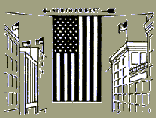
|
|
(k) When used on a speaker's platform, the flag, if displayed flat, should be displayed above and behind the speaker. |

|
|
When displayed from a staff in a church or public auditorium, the flag of the United States of America should hold the position of superior prominence, in advance of the audience, and in the position of honor at the clergyman's or speaker's right as he faces the audience. Any other flag so displayed should be placed on the left of the clergyman or speaker or to the right of the audience. (l) The flag should form a distinctive feature of the ceremony of unveiling a statue or monument, but it should never be used as the covering for the statue or monument. (m) The flag, when flown at half-staff, should be first hoisted to the peak for an instant and then lowered to the half-staff position. The flag should be again raised to the peak before it is lowered for the day. |

|
|
On Memorial Day the flag should be displayed at half-staff until noon only, then raised to the top of the staff. By order of the President, the flag shall be flown at half-staff upon the death of principal figures of the United States Government and the Governor of a State, territory, or possession, as a mark of respect to their memory. In the event of the death of other officials or foreign dignitaries, the flag is to be displayed at half-staff according to Presidential instructions or orders, or in accordance with recognized customs or practices not inconsistent with law. In the event of the death of a present or former official of the government of any State, territory, or possession of the United States, the Governor of that State, territory, or possession may proclaim that the National flag shall be flown at half-staff. The flag shall be flown at half-staff thirty days from the death of the President or a former President; ten days from the death of the Vice President, the Chief Justice or a retired Chief Justice of the United States, or the Speaker of the House of Representatives; from the day of death until internment of an Associate Justice of the Supreme Court, a Secretary of an executive or military department, a former Vice President, or the Governor of a State, territory, or possession; and on the day of death and the following day for a Member of Congress. The flag shall be flown at half-staff on Peace Officers Memorial Day, unless that day is also Armed Forces Day. As used in this subsection. (1) the term "half-staff" means the position of the flag when it is one-half the distance between the top and bottom of the staff; (2) the term "executive or military department" means any agency listed under sections 101 and 102 of title 5; and (3) the term "Member of Congress" means a Senator, a Representative, a Delegate, or the Resident Commissioner for Puerto Rico. |
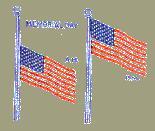
|
| (n) When the Flag is used to cover a casket, it should be so placed that the union is at the head and over the left shoulder. The flag should not be lowered into the grave or allowed to touch the ground. |

|
| When the flag is suspended across a corridor or lobby in a building with only one main entrance, it should be suspended vertically with the union of the flag to the observer's left upon entering. If the building has more than one main entrance, the flag should be suspended vertically near the center of the corridor or lobby with the union to the north, when entrances are to the east and west or to the east when entrances are to the north and south. If there are entrances in more than two directions, the union should be to the east. | |
|
§ 177. Conduct during hoisting, lowering or passing of flag During the ceremony of hoisting or lowering the flag or when the flag is passing in a parade or in review, all persons present except those in uniform should face the flag and stand at attention with the right hand over the heart. Those present in uniform should render the military salute. When not in uniform, men should remove their headdress with their right hand and hold it at the left shoulder, the hand being over the heart. Aliens should stand at attention. The salute to the flag in a moving column should be rendered at the moment the flag passes. |
|
Appendix B
State Board of Education's Regulation on Flag Etiquette
5 CSR 50-865.400 Flag Etiquette
Purpose: This rule provides guidelines for flag etiquette and the correct use and display of the United States of America flag.
- School districts may adopt a program of instruction relating to the flag of the United States of America, instruction in flag etiquette, correct use and display of the flag and its use in other patriotic exercises.
- The program of instruction should include, but not be limited to the following areas:
(A) Times and occasions for display of the flag of the United States, as stated in 36 U.S.C.A. section 174, included as Appendix A to this rule, including:
-
- Displays on buildings and stationary flagstaffs in the open;
- Night display;
- Manner of hoisting the flag;
- Prohibitions on display during inclement weather;
- Appropriate days of display; and
- Display of the flag on or near public buildings, polling places or schoolhouses.
- (B) Proper position and manner of display of the flag of the United States as stated in 36 U.S.C.A. section 175, included as Appendix B of this rule, including:
- Appropriate display of the flag;
- Position of the flag with other flags;
- Inappropriate displays and prohibited uses of the flag; and
- Display of the flag at half-staff.
(C) Showing respect for the flag of the United States, as stated in 36 U.S.C.A. section 176, included as Appendix C of this rule including:
- Personal displays of respect for the flag;
- Prohibited uses of the flag;
- Storage of the flag;
- Prohibitions on alteration of the flag; and
- Appropriate destruction of flag no longer suitable for display; and
(D) Conduct during hoisting, lowering or passing of flag of the United States as stated in 36 U.S.C.A. section 177, included in the rule as Appendix D of this rule.
Authority: section 161.104, RSMo Supp. 1997* Original rule filed March 24, 1998, effective Oct. 30, 1998.
*Original authority 1997.
Appendix C
Respect for flagNo disrespect should be shown to the flag of the United States of America; the flag should not be dipped to any person or thing. Regimental colors, State flags, and organization or institutional flags are to be dipped as a mark of honor.
- The flag should never be displayed with the union down, except as a signal of dire distress in instances of extreme danger to life or property.
- The flag should never touch anything beneath it, such as the ground, the floor, water, or merchandise.
- The flag should never be carried flat or horizontally, but always aloft and free.
- The flag should never be used as wearing apparel, bedding, or drapery. It should never be festooned, drawn back, nor up, in folds, but always allowed to fall free. Bunting of blue, white, and red, always arranged with the blue above, the white in the middle, and the red below, should be used for covering a speaker's desk, draping the front of the platform, and for decoration in general.
- The flag should never be fastened, displayed, used, or stored in such a manner as to permit it to be easily torn, soiled, or damaged in any way.
- The flag should never be used as a covering for a ceiling.
- The flag should never have placed upon it, nor on any part of it, nor attached to it any mark, insignia, letter, word, figure, design, picture, or drawing of any nature.
- The flag should never be used as a receptacle for receiving, holding, carrying, or delivering anything.
- The flag should never be used for advertising purposes in any manner whatsoever. It should not be embroidered on such articles as cushions or handkerchiefs and the like, printed or otherwise impressed on paper napkins or boxes or anything that is designed for temporary use and discard. Advertising signs should not be fastened to a staff or halyard from which the flag is flown.
- No part of the flag should ever be used as a costume or athletic uniform. However, a flag patch may be affixed to the uniform of military personnel, firemen, policemen, and members of patriotic organizations. The flag represents a living country and is itself considered a living thing. Therefore, the lapel flag pin being a replica, should be worn on the left lapel near the heart.
- The flag, when it is in such condition that it is no longer a fitting emblem for display, should be destroyed in a dignified way, preferably by burning.
Appendix D
Conduct during hoisting, lowering or passing of flag.
During the ceremony of hoisting or lowering the flag or when the flag is passing in a parade or in review, all persons present except those in uniform should face the flag and stand at attention with the right hand over the heart. Those present in uniform should render the military salute. When not in uniform, men should remove their headdress with their right hand and hold it at the left shoulder, the hand being over the heart. Aliens should stand at attention. The salute to the flag in a moving column should be rendered at the moment the flag passes.
Published by the
Missouri Department of Elementary and Secondary Education
Robert E. Bartman, Commissioner of Education
December 1998
-



